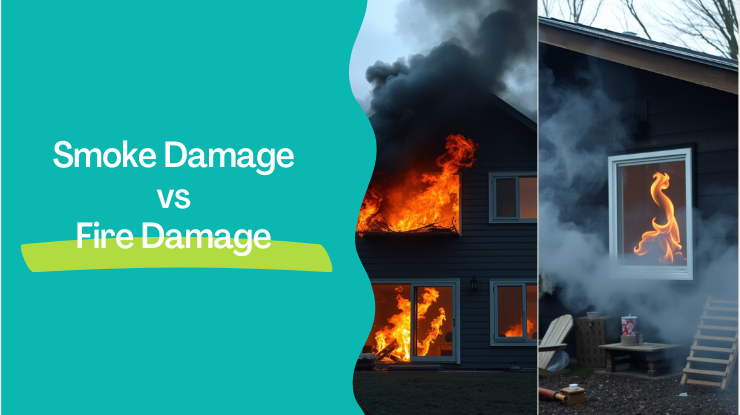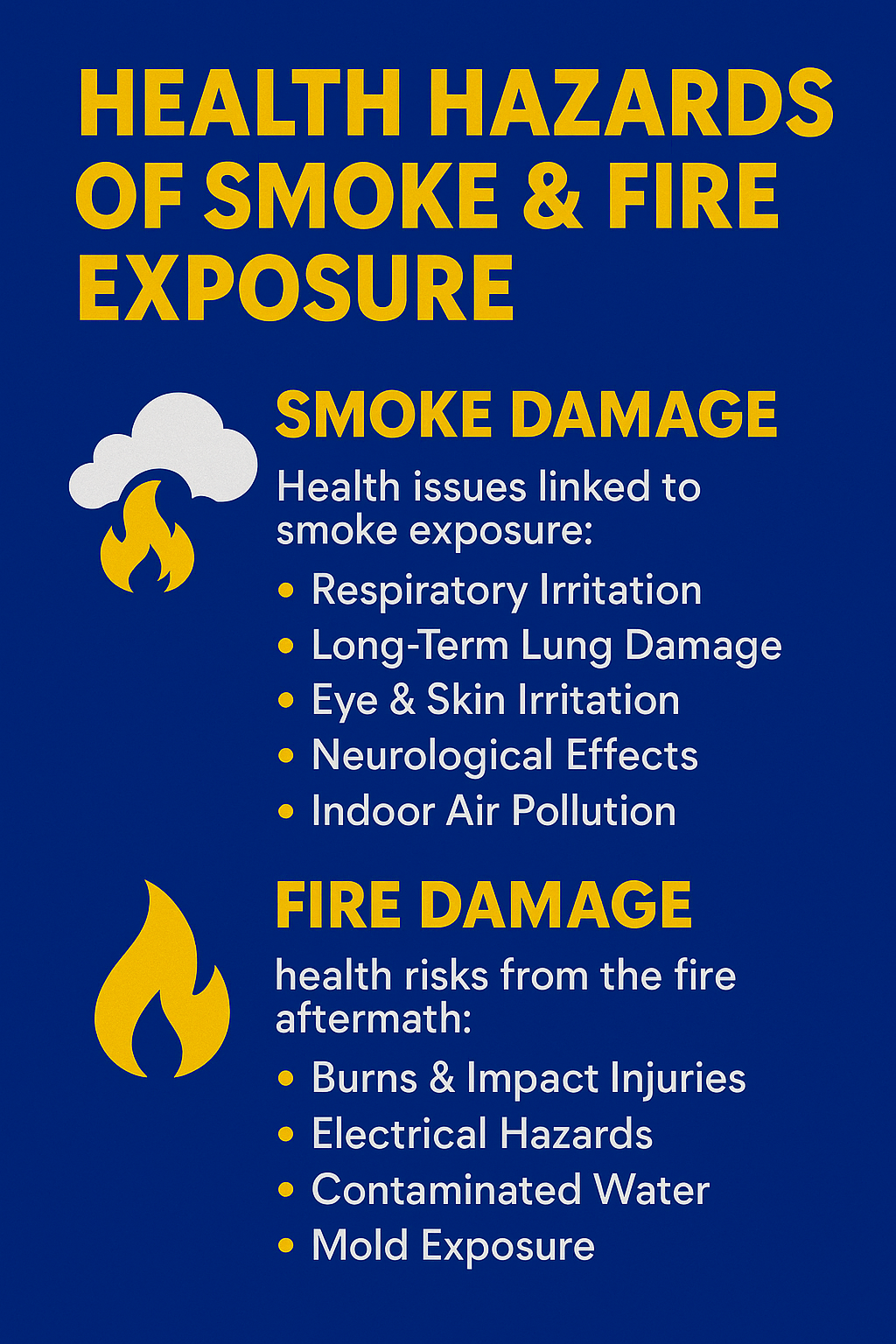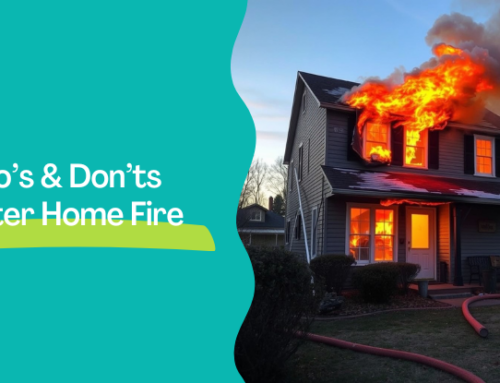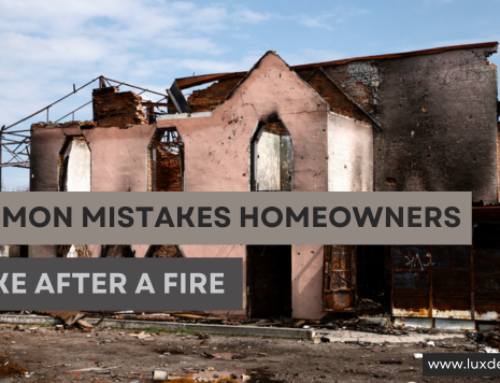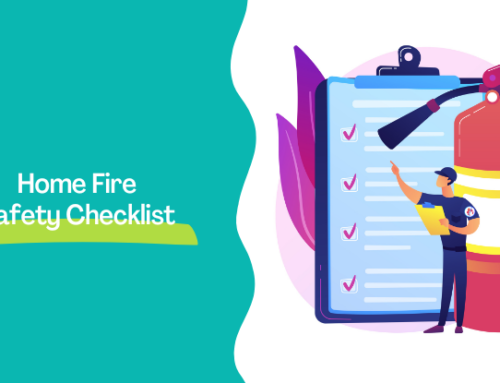What causes long-term damage to a home — the flames of a fire or the lingering effects of smoke?
At first glance, fire seems like the obvious culprit. Its destruction is visible, immediate, and often overwhelming. But smoke — the less visible aftermath — can infiltrate every corner of a home, embedding itself in porous materials, air ducts, and even electronics.
For homeowners, property managers, and restoration professionals alike, understanding the difference between fire damage and smoke damage isn’t just about semantics — it’s about making the right decisions in the crucial hours and days after a disaster.
Whether you’re dealing with charred structural beams, soot-covered walls, or persistent odors that won’t go away, it’s essential to know what you’re up against.
Fire and smoke may originate from the same event, but they behave very differently, require different cleanup approaches, and have vastly different implications for health risks, insurance claims, and restoration strategies.
Unfortunately, these aren’t just hypothetical scenarios. Across the United States, recent wildfire events have shown the staggering impact that both fire and smoke can have on homes, cities, and natural environments — sometimes in ways that homeowners never expected.
Before we explore the technical differences between the two types of damage, let’s look at a few powerful examples from 2025 that make the threat very real.
Contents
- Real-World Wildfires (2025): A Wake-Up Call to the Power of Fire and Smoke
- Understanding Fire Damage – The Visible Destroyer
- Common Types of Fire Damage:
- Restoration Priorities After Fire Damage:
- Understanding Smoke Damage – The Invisible Intruder
- Smoke Damage vs. Fire Damage – Key Differences Explained
- Health Hazards of Smoke and Fire Exposure
- Smoke Damage: The Silent Health Threat
- Fire Damage: Physical and Environmental Hazards
- Expert Restoration Tips for Fire and Smoke Damage
- Immediate Actions to Take After a Fire (Regardless of Damage Type)
- Smoke Damage Restoration Tips
- Fire Damage Restoration Tips
- DIY vs. Professional Restoration – When to Call the Experts
- When DIY May Be Safe (Very Minor Smoke Damage Only)
- Why Professional Restoration Is Often Essential
Real-World Wildfires (2025): A Wake-Up Call to the Power of Fire and Smoke
The first few months of 2025 have already delivered a harsh reminder of how destructive fires — and the smoke they produce — can be. While media coverage often focuses on charred buildings and raging flames, the invisible aftermath of smoke frequently causes just as much, if not more, long-term damage.
According to LA County – In California, the Eaton Fire ravaged over 14,000 acres in Los Angeles County, destroying more than 9,400 structures and leaving thick smoke residue in properties miles beyond the fire line. Just weeks later, the Palisades Fire consumed nearly 24,000 acres near Malibu. Although some homes were spared from direct flames, they suffered heavy internal smoke contamination — from soot-coated walls to long-term odor retention in furnishings.
The Silver Fire in Inyo County brought another layer of concern by threatening the ancient Bristlecone Pine Forest. Here, conservation teams noted that even areas that never burned were affected by smoke haze and particulate matter — an example of how airborne contaminants can compromise entire ecosystems.
According to NY Post – On the East Coast, Brooklyn’s Marine Park experienced over 50 acres of wildfire damage within six months — an unprecedented urban fire event. As a result, city officials are now planting non-flammable, native vegetation to help curb the spread of both fire and smoke in densely populated areas.
All these events show just how destructive and far-reaching both fire and smoke damage can be — often affecting buildings, belongings, and air quality well beyond the visible fire perimeter.
To truly understand how to protect and restore your home, we first need to break down what exactly fire damage is — and how it manifests inside residential and commercial properties.
Understanding Fire Damage – The Visible Destroyer
When most people picture the aftermath of a fire, they think of blackened walls, scorched ceilings, and collapsed roofs. This is fire damage in its most recognizable form — the direct result of flames, heat, and combustion destroying physical materials.
It’s highly visible, often severe, and typically concentrated in the areas closest to the fire’s origin.
Fire damage occurs through three primary mechanisms:
- Direct contact with flames, which consumes and destroys materials like wood, drywall, and plastic.
- Heat exposure, which can warp or melt surfaces even without direct flame.
- Structural compromise, where critical elements like beams or joists are weakened and lose their load-bearing capability.
Common Types of Fire Damage:
- Structural Damage: Walls, ceilings, support beams, roofing, and subflooring may be partially or fully destroyed.
- Material Loss: Belongings made of flammable materials — furniture, fabrics, books, electronics — are often burned beyond repair.
- Heat Degradation: Even materials not touched by fire may be warped, cracked, or permanently damaged due to intense heat exposure.
- Electrical System Damage: Wiring inside walls or ceilings may melt or short-circuit, posing ongoing safety risks.
- Secondary Water Damage: Often caused by firefighting efforts, adding to the overall restoration burden.
Unlike smoke, fire damage is typically contained to the source area, but the cost and effort involved in repairing it are usually higher due to the need for demolition, reconstruction, and safety inspections.
For homeowners, this can mean anything from replacing a few walls to completely rebuilding key parts of the structure.
Restoration Priorities After Fire Damage:
- Safety Inspection: Ensuring the structure is stable before any cleanup or rebuilding.
- Debris Removal: Disposing of burned materials and hazardous remnants.
- Dry-Out (if needed): Addressing water damage from firefighting to prevent mold growth.
- Reconstruction: Replacing structural and cosmetic elements to restore the home’s integrity and appearance.
- Electrical and Mechanical Checks: Ensuring systems are safe and up to code.
But even after the flames are gone and the walls are rebuilt, another threat often lingers in the air — quite literally.
Let’s now take a closer look at smoke damage — the invisible, widespread intruder that can seep into places fire never touched.
Understanding Smoke Damage – The Invisible Intruder
While fire damage leaves visible destruction in its wake, smoke damage is often far more deceptive — and widespread. Even in areas untouched by flames, smoke can seep into every crack, crevice, and porous surface, leaving behind an array of contaminants that affect both property and health.
Smoke is made up of microscopic particles, gaseous chemicals, and residues created during the combustion of materials.
These particles cling to surfaces, penetrate fabrics, travel through HVAC systems, and settle in electronics — often going unnoticed until odors or malfunctions occur.
Types of Smoke Damage:
- Soot Residue: A black, powdery, or greasy substance made of unburned carbon. It settles on walls, ceilings, furniture, and electronics and can cause permanent staining and corrosion.
- Smoke Odor: A persistent, musty, or acrid smell that lingers in carpets, curtains, and upholstery. These odors often require deep cleaning and deodorization techniques to remove.
- Acidic Film: Smoke contains acidic compounds that begin to corrode metals and degrade materials within hours of exposure.
- Invisible Particulates: Microscopic particles can infiltrate air ducts and HVAC systems, contaminating indoor air long after the fire is extinguished.
- Health Risks: Inhalation of smoke particles can irritate the respiratory system, aggravate asthma, and lead to long-term health issues with repeated exposure.
Unlike fire damage, smoke damage is rarely confined to one location. Because smoke moves with airflow, it can spread throughout an entire property — affecting rooms, closets, ventilation systems, and hidden cavities that might seem untouched.
Smoke Damage Behaviors to Consider:
- It travels upward and outward from the source.
- It clings more heavily to cooler surfaces.
- It affects porous materials faster and more deeply.
- It can chemically interact with materials, accelerating decay and odor retention.
Restoration Priorities After Smoke Damage:
- Ventilation: Circulating fresh air as soon as it is safe to do so.
- Assessment: Professional inspection of affected materials and systems.
- Surface Cleaning: Using specialized dry or wet cleaning methods depending on residue type.
- Odor Neutralization: Applying ozone treatment, thermal fogging, or air scrubbers.
- HVAC System Cleaning: Removing soot particles and contaminants from ducts and vents.
Now that we’ve explored how smoke and fire damage operate individually, it’s time to compare their restoration complexity, long-term consequences, and recovery implications.
Smoke Damage vs. Fire Damage – Key Differences Explained
This side-by-side table focuses on practical distinctions that affect your decisions as a homeowner, contractor, or restoration professional.
This side-by-side table focuses on practical distinctions that affect your decisions as a homeowner, contractor, or restoration professional.
| Aspect | Smoke Damage | Fire Damage |
|---|---|---|
| Detection Difficulty | Often unnoticed until odors or discoloration appear | Immediately visible and identifiable |
| Restoration Duration | Longer cleanup phase due to odor elimination and deep material penetration | Longer rebuild time due to structural repairs and inspections |
| Insurance Claim Complexity | Often harder to prove and document; some policies limit smoke-specific coverage | Typically easier to document; more visual proof and structural loss |
| Secondary Damage Risk | Can lead to mold (via trapped moisture), corrosion, and HVAC contamination | Can cause water damage from firefighting and electrical faults |
| Lingering Impact | Odor and air quality issues can persist for months if not treated professionally | Structural issues will be resolved once rebuilding is complete |
| Cost Variables | Costs depend on contamination spread and deodorization needs | Costs driven by demolition, rebuilding, and material loss |
| Psychological Impact | Constant odors and “invisible contamination” may increase stress/anxiety | The trauma of seeing physical destruction often has an immediate impact |
This comparison highlights a crucial truth: Both fire and smoke can devastate a property, but their effects differ not only in visibility but in how they disrupt your life over time.
And while one leaves visible scars, the other may silently threaten your home’s livability and your family’s well-being.
That brings us to the next critical factor many homeowners underestimate: the health risks associated with fire and smoke exposure.
Let’s look at how each one can impact your physical and mental health — both in the short term and long term.
Health Hazards of Smoke and Fire Exposure
Both smoke exposure and fire-related hazards pose significant risks to your health, especially if not addressed during the restoration process.
Smoke Damage: The Silent Health Threat
Smoke isn’t just a lingering odor — it’s a complex mixture of fine particulates, volatile organic compounds (VOCs), carbon monoxide, and other toxic byproducts of combustion. These contaminants are especially dangerous because they can accumulate in the lungs and re-enter circulation every time you breathe.
Health issues linked to smoke exposure:
- Respiratory Irritation: Coughing, wheezing, sore throat, and asthma flare-ups
- Long-Term Lung Damage: Especially dangerous for children, elderly individuals, and those with pre-existing conditions
- Eye and Skin Irritation: Burning, itching, and sensitivity caused by fine particles
- Neurological Effects: Headaches, dizziness, and cognitive fog due to carbon monoxide exposure
- Indoor Air Pollution: Lingering particulates in the air and HVAC systems, contributing to chronic exposure
Even minimal smoke damage can leave behind invisible toxins embedded in walls, furniture, and air ducts — which is why professional remediation is critical.
Fire Damage: Physical and Environmental Hazards
Fire itself presents more immediate physical risks, especially during or just after the event. In addition to burn injuries and heat-related trauma, structural instability poses a severe danger in the aftermath.
Common health risks from the fire aftermath:
- Burns and Impact Injuries: From collapsing structures, falling debris, or walking through unsafe zones
- Electrical Hazards: Damaged wiring can cause electrocution or reignite fires
- Contaminated Water: Water used to extinguish flames can mix with soot, chemicals, and bacteria, creating biohazards
- Mold Exposure: Water damage leads to mold, which brings its own respiratory and immune risks
In many cases, homes that appear “safe to re-enter” after a fire still harbor unseen dangers. That’s why a certified inspection and indoor air quality test are essential before re-occupying the space.
Expert Restoration Tips for Fire and Smoke Damage
After a fire event, your instinct might be to start cleaning immediately — but without the right approach, you could worsen the damage or risk your health. Whether your home was affected by flames, smoke, or both, the first 24–48 hours are crucial for minimizing long-term impact and beginning an efficient, safe restoration process.
Immediate Actions to Take After a Fire (Regardless of Damage Type)
- Ensure Safety First: Only re-enter the property after it’s been cleared by fire officials or restoration professionals. Structural damage, exposed wiring, or lingering smoke can pose serious threats.
- Contact Certified Restoration Experts: Bring in a licensed team like Lux Construction Group to assess both visible and invisible damage, including smoke residue and air quality issues.
- Notify Your Insurance Provider: Start the claims process immediately. Document everything with photos and video, and avoid cleaning until after an adjuster has reviewed the property.
- Avoid Touching Soot or Ash: Soot is acidic and can smear, spread, or set into materials. Leave items undisturbed for proper professional treatment.
- Improve Ventilation (If Safe): If approved by a specialist, open windows and doors to allow fresh air circulation — but avoid using HVAC systems until they’re inspected.
Smoke Damage Restoration Tips
Smoke damage tends to spread far beyond the fire source. Restoring air quality and removing residue requires specialized techniques and equipment.
- Professional Cleaning of Walls, Ceilings, and Contents: Use dry sponges for soot removal, followed by wet cleaning methods where appropriate. Porous materials may require replacement.
- Odor Neutralization: Use ozone generators, thermal fogging, or hydroxyl machines only with professional guidance to avoid health risks.
- HVAC Decontamination: Soot and odor particles collect in air ducts and can re-circulate contaminants. Full HVAC system cleaning is essential.
- Textile and Upholstery Restoration: Soft goods (rugs, drapes, bedding) should be treated with ultrasonic cleaning or dry cleaning to remove embedded particles and smells.
- Sealing and Repainting: Smoke can penetrate paint layers. After cleaning, apply a sealing primer before repainting to trap any residual odor molecules.
Fire Damage Restoration Tips
Fire damage is often structural and may require partial demolition and rebuilding. Timelines are typically longer and require collaboration with contractors, inspectors, and adjusters.
- Structural Assessment and Demolition: Prioritize the inspection of beams, joists, flooring, and roofing for integrity and safety.
- Debris and Hazard Removal: Safely remove all burned or damaged materials, including appliances and construction debris.
- Water Damage Mitigation: Address water from fire hoses or sprinkler systems to prevent mold and secondary damage.
- Rebuilding and Restoration: Work with licensed contractors to restore everything from framing and drywall to electrical and finish work.
- Final Inspections and Testing: Ensure your home is code-compliant, structurally sound, and cleared for re-occupancy with proper air quality.
Whether you’re dealing with smoke infiltration, structural fire loss, or both, the safest and most effective recovery starts with professional help. Luxdevla offers certified fire and smoke damage restoration throughout Southern California — from full structural repair to odor elimination and air quality testing. Contact us today to get a fast, personalized assessment.
After a fire or smoke incident, many homeowners are tempted to take matters into their own hands.
DIY vs. Professional Restoration – When to Call the Experts
While this is understandable, it’s important to know where DIY methods fall short — and where they can actually make the damage worse or delay insurance claims.
When DIY May Be Safe (Very Minor Smoke Damage Only)
There are limited cases where homeowners can address small smoke issues themselves — typically in areas far removed from the fire source or where the smoke exposure was brief.
You may consider DIY if:
- The smoke exposure was from a contained incident (like burnt food or a candle fire).
- Only one room is affected, and there’s no visible soot on ceilings or walls.
- The HVAC system was off at the time and has not circulated smoke.
- You have protective gear and understand safe cleaning practices.
DIY-safe steps include:
- Opening windows and using air purifiers
- Using a dry cleaning sponge (chemical sponge) on walls
- Wash washable fabrics like curtains and bedding with odor-neutralizing detergent
- Light surface cleaning with baking soda, vinegar, or commercial degreasers
Why Professional Restoration Is Often Essential
Even what seems like a “minor” incident can hide deep contamination, structural threats, and serious health hazards. Attempting to clean smoke or fire damage without proper equipment can:
- Push soot deeper into materials
- Void your insurance coverage
- Exposing you to dangerous chemicals or particulates
- Missed hidden damage in HVAC systems, wiring, or insulation
Professional restoration teams, like Lux Construction Group, offer:
- Specialized tools (HEPA vacuums, thermal foggers, ozone machines)
- Knowledge of different smoke types (wet smoke, dry smoke, protein residue)
- Full HVAC cleaning and duct sanitization
- Insurance-compatible documentation and estimates
- Material-specific restoration or replacement advice
In most fire or smoke scenarios, hiring certified professionals isn’t a luxury — it’s a necessity for safe, thorough, and insurable recovery.

